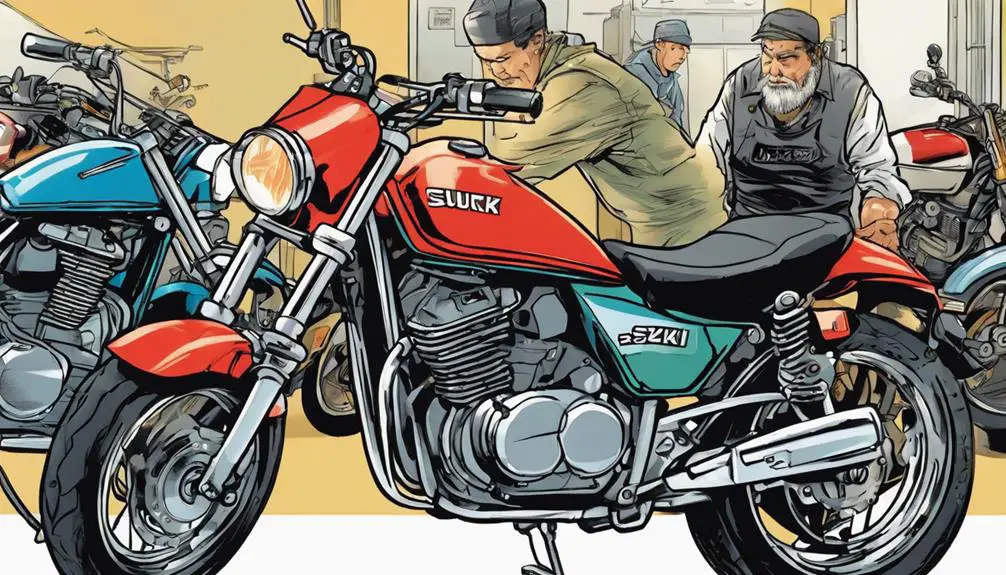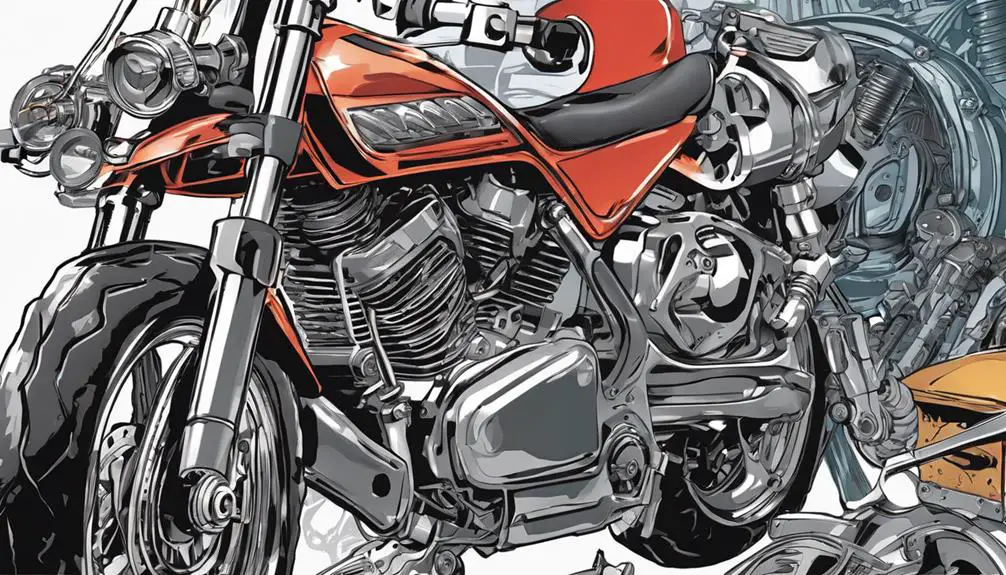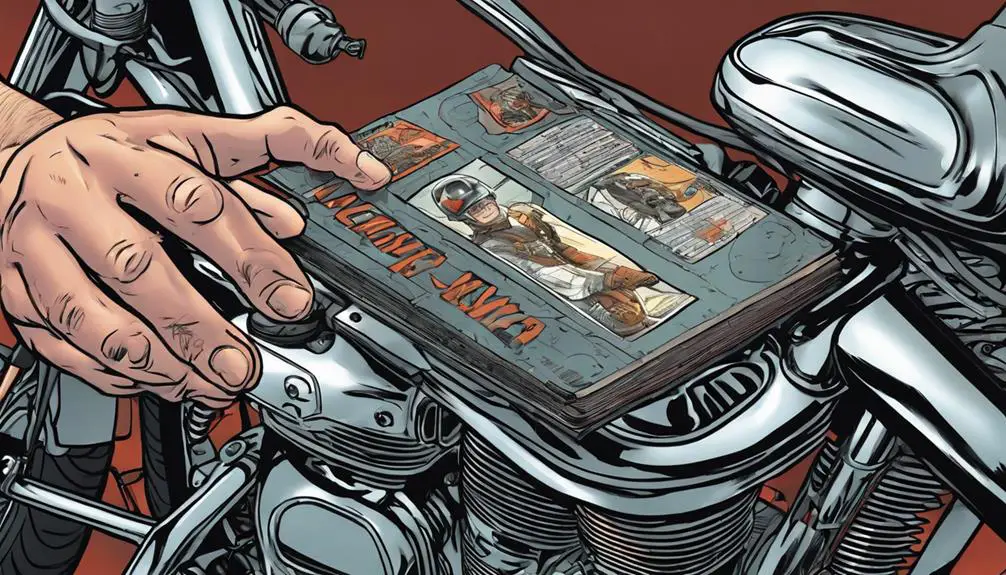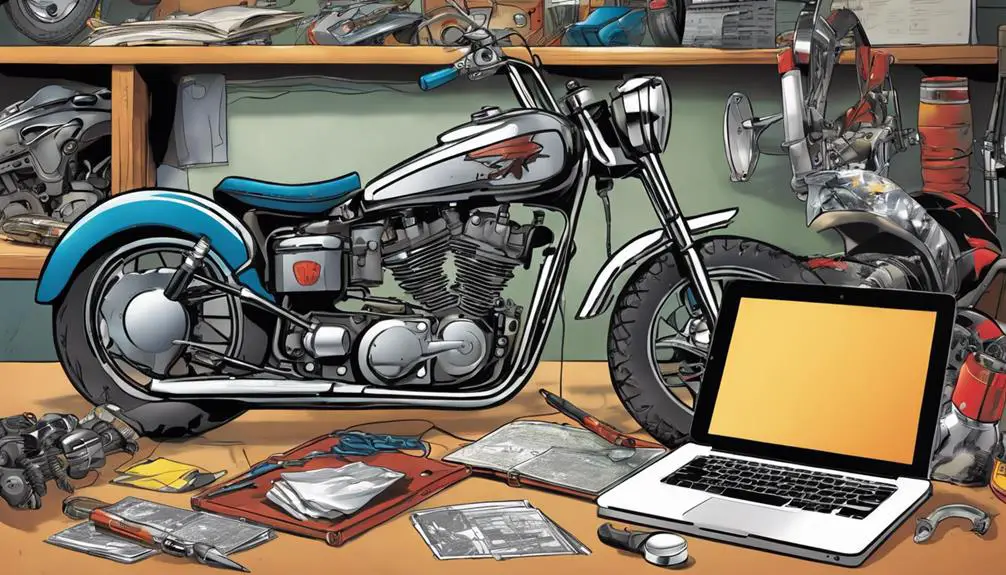When you're looking to guarantee motorcycle parts compatibility, you need to start by understanding your specific model, including its year and specifications. Using the Vehicle Identification Number (VIN) can simplify this process, allowing you to contrast OEM and aftermarket options effectively. It's essential to pay attention to dimensions and materials to avoid performance issues. But how do you navigate the potential pitfalls and leverage available resources to make informed choices? The answers may surprise you and could save you from costly mistakes.
Quick Takeaways
- Check the motorcycle's VIN and part numbers for accurate compatibility with OEM and aftermarket parts for your specific model year.
- Verify dimensions, material compatibility, and electrical specifications to ensure proper fit and performance under stress.
- Research both OEM and aftermarket options to weigh quality, warranty, and customization benefits for your riding needs.
- Consult manufacturer websites and online communities for specifications, compatibility charts, and shared experiences from other riders.
Understanding Suzuki Motorcycle Models

When you're looking to guarantee compatibility, understanding the different Suzuki motorcycle models is essential. Suzuki offers a diverse lineup, each tailored to various riding styles and preferences. From the agile GSX series designed for speed enthusiasts to the versatile V-Strom, which caters to adventurous spirits, knowing your model helps you choose the right parts.
You'll want to identify whether your bike is a sport, cruiser, or touring model. Each category has unique features, and parts designed for one may not fit another. Familiarizing yourself with the specifications of your model guarantees you won't waste time or money on incompatible components.
Additionally, consider how your motorcycle's age affects part availability. Older models might require you to search harder for specific parts, while newer ones often have more options readily available. Understanding the nuances of each model, including their distinct characteristics, makes it easier to find compatible parts that enhance performance and safety.
Ultimately, embracing this knowledge not only empowers you as a rider but also liberates your journey, letting you explore the open road with confidence in your machine.
Key Specifications to Consider
When you're looking to guarantee compatibility, it's vital to take into account several key specifications.
You'll want to weigh the pros and cons of OEM versus aftermarket parts, check model year compatibility, and guarantee the component specifications match.
Paying attention to these factors can save you time and money down the road.
OEM Vs. Aftermarket Parts
Understanding the differences between OEM and aftermarket parts is essential for ensuring compatibility and performance in your motorcycle.
OEM (Original Equipment Manufacturer) parts are made by the manufacturer of your bike, ensuring a perfect fit and maintaining the original specifications. They're often seen as the gold standard because they match what your motorcycle was designed for, offering reliability and peace of mind.
On the other hand, aftermarket parts can be a liberating choice. They're produced by third-party companies and often come at lower prices. While quality varies, many aftermarket options are designed to enhance performance or offer unique aesthetics, allowing you to customize your ride. However, you'll need to do your research; not all aftermarket parts are created equal.
When considering either option, think about specific factors like material quality, warranty, and performance. For instance, some aftermarket parts might improve your bike's horsepower or handling but could compromise durability.
Ultimately, weigh your priorities against your budget. Choosing the right parts empowers you to elevate your motorcycle experience while staying true to your vision of freedom on the road.
Model Year Compatibility
Model year compatibility plays a significant role in ensuring that the parts you choose will fit and function properly with your motorcycle. When you're planning upgrades or repairs, you can't overlook the fact that even slight changes in design or specifications from year to year can affect how parts interact. Each model year might introduce new technologies or modify existing features, so it's essential to know exactly which year your motorcycle belongs to.
Start by checking your motorcycle's VIN (Vehicle Identification Number), which will help you identify the exact model year. Once you know that, you can confidently search for parts that are explicitly labeled for your model year. Keep in mind that even parts that look similar mightn't work due to subtle differences in design.
If you're considering aftermarket options, double-check that they're compatible with your specific model year. Don't just rely on general claims; manufacturers often provide detailed specifications that you should compare against your motorcycle's requirements.
Component Specifications Matching
Ascertaining that component specifications match is essential for achieving ideal performance and safety in your motorcycle. When you're upgrading or replacing parts, you can't just go with what looks good; you need to dig deeper into the specifics. Start with dimensions, like diameter and length, to ascertain proper fit. If a part doesn't fit seamlessly, it could compromise your ride.
Next, pay attention to material compatibility. The strength and durability of materials can affect performance, especially under high stress. For instance, using a lightweight alloy can enhance agility, but it may not hold up under extreme conditions.
Don't forget about the electrical specifications, too. Voltage ratings and connector types must align; mismatched electrical components can lead to frustrating failures.
Lastly, consider the performance ratings. Whether it's brakes, suspension, or engine components, understanding their limits can help you maintain control and achieve the riding experience you crave.
OEM Vs Aftermarket Parts

When it comes to motorcycle parts, you'll often find yourself choosing between OEM and aftermarket options, each with its own set of advantages and drawbacks.
OEM, or Original Equipment Manufacturer, parts are made by the manufacturer of your motorcycle. They guarantee a perfect fit and often come with a warranty, providing peace of mind. However, they can be pricier and may not always offer the performance upgrades you crave.
On the other hand, aftermarket parts are produced by third-party companies. They often provide a wider variety of options, letting you customize your ride to suit your style and performance preferences. These parts can be more affordable, allowing you to save some cash while still enhancing your bike. However, not all aftermarket parts are created equal. Some might compromise quality or compatibility, so you'll need to do your homework.
Ultimately, the choice between OEM and aftermarket parts boils down to your values and needs as a rider. Do you prioritize reliability and fit, or are you seeking freedom to personalize your motorcycle? Your decision will shape your riding experience, so choose wisely!
Compatibility With Accessories
How can you make certain your motorcycle accessories fit seamlessly with your bike's existing parts?
First, consider the type of accessories you want to add. Whether it's a new exhaust system, handlebars, or lights, each accessory can affect your bike's performance and aesthetics. Look for parts that are specifically designed for your motorcycle model to avoid compatibility issues.
Next, think about how the new accessories will interact with your existing components. Will a new windshield affect your handlebars? Will upgraded lights demand more from your electrical system? Assess the overall balance and functionality of your bike to guarantee everything works in harmony.
Don't hesitate to consult reviews or forums dedicated to your motorcycle model. Riders often share their experiences, helping you identify which accessories fit well and which might cause trouble.
Lastly, consider installation. Some accessories may require more than just a simple bolt-on. Check if you'll need additional hardware or tools to make your new parts work together.
Ultimately, your ride should embody freedom and individuality; confirming compatibility with accessories is vital for releasing the full potential of your motorcycle.
Checking VIN and Part Numbers

Checking your motorcycle's VIN and part numbers is essential for confirming that any replacement or upgrade parts will fit properly. By guaranteeing you're working with the correct information, you can ride with confidence, knowing your bike's performance won't be compromised.
Here's how to check:
- Locate Your VIN: Your motorcycle's Vehicle Identification Number (VIN) usually sits on the frame, near the steering head. It's a unique code that identifies your bike's make, model, and year.
- Find Part Numbers: Look up the part numbers for the components you're interested in replacing or upgrading. These numbers can often be found in your owner's manual or through the manufacturer's website.
- Cross-Reference: Use both the VIN and part numbers to guarantee compatibility with any potential replacements. Many online retailers and forums can help you verify if the parts will fit your specific model.
Common Compatibility Issues
Motorcycle enthusiasts often encounter common compatibility issues that can lead to performance problems or even safety hazards. One major issue is mixing parts from different model years. Even slight variations in design can result in poor fit or functionality. For instance, a clutch cable from one model mightn't operate correctly on another, causing gear-shifting headaches or worse.
Another frequent pitfall is using aftermarket parts. While they can be tempting for their price or aesthetic appeal, not all aftermarket components meet the same standards as OEM parts. You might find that a low-cost exhaust doesn't align properly, affecting not just performance but also your ride's sound and emissions.
It's also essential to take into account electrical components. Your bike's wiring harness is uniquely tailored, and using incompatible connectors can lead to shorts or electrical failures.
Lastly, don't overlook tire compatibility. Tires that don't match your bike's specifications can compromise handling and safety.
To keep your ride smooth and secure, always double-check compatibility before purchasing parts. A little diligence goes a long way in ensuring you enjoy the freedom of the open road without worry.
Resources for Parts Compatibility

Ensuring parts compatibility is easier when you utilize reliable resources designed to guide your choices. By tapping into these tools, you can confidently select the right components for your motorcycle, freeing yourself from the worry of mismatched parts.
Here are three valuable resources to help you on your journey:
- Manufacturer Websites: Always check the official site of your motorcycle's brand. They often have detailed specifications and compatibility charts that help you make informed decisions.
- Online Forums and Communities: Engaging with fellow riders can be enlightening. Sites like Reddit or specialized motorcycle forums offer firsthand experiences from people who've been in your shoes, sharing what worked for them.
- Parts Compatibility Checkers: Websites like BikeBandit or RevZilla provide tools to input your bike's make, model, and year, giving you a list of compatible parts. These platforms save you time and reduce the risk of errors.
With these resources at your disposal, you can embrace the freedom of customization without the fear of incompatibility. Equip yourself with knowledge, and let your motorcycle reflect your unique spirit!
Common Questions
Can I Use Parts From Different Motorcycle Brands?
You can definitely use parts from different motorcycle brands, but it's not always straightforward.
You'll need to take into account factors like size, mounting points, and compatibility with your bike's systems.
Mixing and matching can release creativity and enhance your ride, but it might require some modifications or custom work.
Always double-check the specifications and consult with experts if you're unsure.
Embrace the freedom of customizing your ride while ensuring safety and performance!
How Does Riding Style Affect Parts Compatibility?
Your riding style shapes your bike's performance, just like a dancer's movements define their grace.
If you're a speed demon, you'll need parts that enhance acceleration and stability.
Meanwhile, if you prefer cruising, comfort-focused components matter more.
Each style demands specific features, affecting compatibility.
So, when you choose parts, consider how you ride—they should complement your unique approach to freedom on two wheels.
Embrace your style and select wisely!
What Tools Are Needed for Part Installation?
To install motorcycle parts effectively, you'll need a few essential tools.
Start with a good set of wrenches and sockets, as they'll help you tackle various bolts and nuts. A torque wrench guarantees you're tightening everything to the right specifications.
Don't forget screwdrivers for smaller components and pliers for gripping.
A reliable service manual can guide you through specific steps, and safety gear is vital for protecting yourself while you work.
Are There Online Forums for Compatibility Discussions?
You'd think finding online forums for compatibility discussions would be as easy as a Sunday ride, but it's not always that straightforward.
You can immerse yourself in platforms like Reddit or specialized motorcycle sites where enthusiasts share tips and experiences. Engage in conversations, ask questions, and you'll soon discover a community enthusiastic to help.
It's liberating to connect with fellow riders who've navigated the same challenges you're facing—together, you'll conquer those compatibility conundrums!
How Often Should I Check Part Compatibility?
You should check part compatibility regularly, especially before making any upgrades or replacements.
It's wise to review compatibility whenever you're planning a ride or working on your bike.
Changes in your bike's setup, or new parts hitting the market, can affect what fits.
Staying proactive keeps your ride smooth and guarantees you're not left stranded.
Embracing that freedom means being aware of what works best for your motorcycle!
Wrapping Up
Ensuring motorcycle parts compatibility might seem challenging, but it doesn't have to be.
By focusing on your specific model and using your VIN, you can easily find the right parts.
Don't worry if you're new to this—there are plenty of resources and communities out there to help you out.
With a little research, you'll feel confident in your choices and enjoy the ride even more, knowing everything fits perfectly and performs well.